Ants as sentinels of the impact of global change
PDF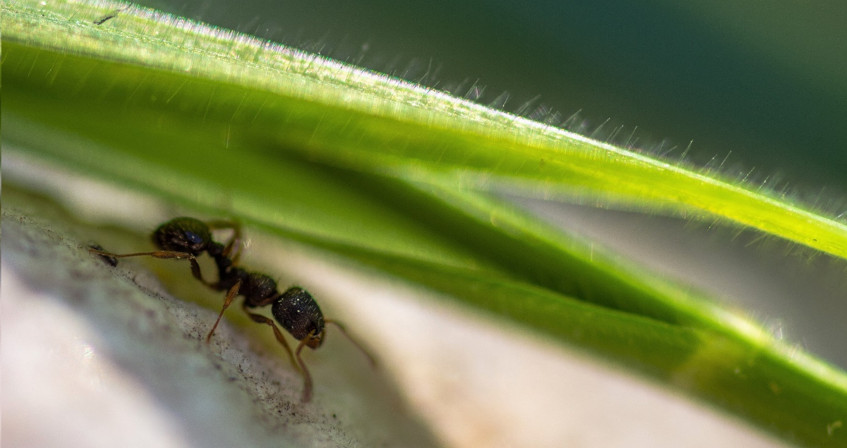
Climate change and urbanization are determining factors in the distribution of species, dramatically threatening their persistence. Biological invasions modify the interactions between different species and are therefore also a major cause of concern for biodiversity conservation. What about ants in this changing world? Dominating many ecosystems, they have already colonized almost all terrestrial habitats. They are easily transported by humans because of their small size and nesting habits, and include some of the most invasive species in the world. Ants do not produce internal heat and are dependent on the outside temperature (they are said to be ectothermic). They are therefore very vulnerable to climate change. In the past, they have answered many questions about ecology and evolution. How might ants help (and how do they already help!) to better understand global changes and their interactions?
1. Global changes: what impacts for biodiversity?
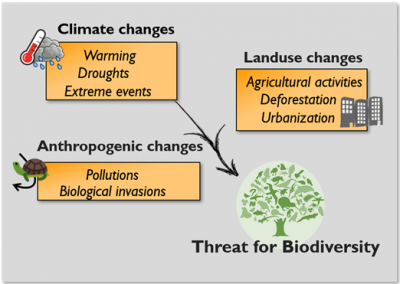
These changes have and will have considerable impacts on biodiversity, affecting individuals, populations, species and ecosystems. For example, changes in temperature can affect the survival, reproduction and geographical distribution of organisms, or even change their phenology, leading to the premature emergence of butterflies, the earlier return of migratory birds or the earlier flowering of plants (see Climate change and globalisation, drivers of insect invasions; How do birds adapt to a changing climate?).
Urbanization is also a rapid and large-scale global change that has a profound impact on biodiversity. Currently, more than 50% of the world’s human population and about 80% of the European population live in urban areas [1]. Urbanisation has a recent but explosive growth trend in most European countries, affecting first the major cities, but also progressively smaller towns and even remote rural villages [2]. The expansion of cities is therefore an important cause of land conversion into urban landscapes that have been heavily modified by man. Urban areas are characterised by a high density of built-up areas, impermeable surfaces with high heat retention capacity, extensive transport infrastructure networks and a high intensification of agricultural activities on their periphery. For biodiversity, urban habitats are therefore profoundly modified habitats combining artificial surfaces, industrial pollution, anthropogenic disturbances and changes in energy and nutrient cycles. Urbanization thus affects all components of the environment, from soils and hydrology
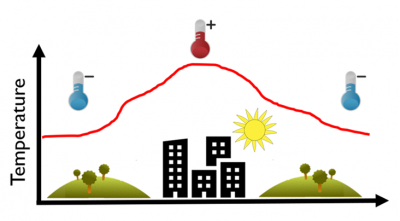
Consequently, from an ecological point of view, urbanization often has a negative impact on biodiversity. Cities are frequently located in naturally species-rich areas with serious conservation challenges [5]. In addition to the impacts already mentioned, urbanization can lead to a cascade of secondary effects on habitat quality, including a decrease in available habitats, high fragmentation of remaining habitats, and increased exposure to edge effects [6]. Consequences for biodiversity have been reported for many taxa (vertebrates, insects, plants, fungi and micro-organisms), for example in response to pollution, disruption of nutrient flows or landscape fragmentation (see Lichens and environmental quality).
Biological invasions [7] have also received increased scientific attention over the past two decades. Indeed, although strictly speaking they are neither new phenomena nor exclusively of human origin, the geographical scope of invasions, their recurrence rate and the number of species involved have increased sharply as a result of the development of transport and trade (see Climate change and globalisation, drivers of insect invasions; Why is the tiger mosquito so invasive?). The role of humans as “dispersers” of non-native species has thus probably surpassed that of natural dispersal, allowing them to overcome natural stochastic forces and biotic resistance (competition with local species) that would repel or eliminate introduced propagules [8]. Ecosystems and human society have thus been radically altered by the proliferation of invasive species, particularly in the current era of globalization. This current event of unprecedented mass invasion is now considered a unique form of global change [8].
As a result, biological invasions are currently one of the main concerns for biodiversity conservation. Non-native species negatively affect native species through a multitude of interactions, such as competition, predation, hybridization, herbivory, parasitism, but also indirectly through diseases or changes in disturbance regimes. Invasive non-native species modify the functioning of ecosystems, negatively affect populations of other species and cause local extinctions [9]. In the United Kingdom, for example, competition between the introduced grey squirrel (Sciurus carolinensis) and the native red squirrel (Sciurus vulgaris) has led to a drastic reduction in the range of the red squirrel [10].
2. Why study ants when we are interested in global change?
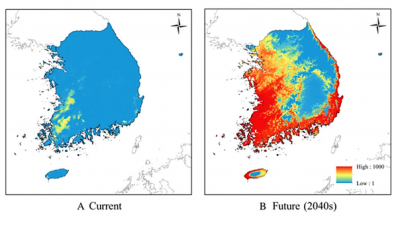
This high abundance and impressive diversity make ants a model of choice for biological monitoring: they are often “keystone” species, which have a major influence on many ecosystem functions such as seed dispersal or soil chemistry, particularly because of their incredible diversity of lifestyles. For example, there are nomadic species, species that nest in trees, in the soil or in vegetation debris, predatory species, other granivores, and some even cultivate mushrooms [13]. Ants are easily transported by humans because of their small size and nesting habits, for example through the trade in potted plants, during excavation work or through logging. In fact, more than 200 species of ants have established populations outside their native range [13] and more than 600 species have already been moved outside their native area [14]. Among them, some have become invasive, i.e. they have proliferated and their expansion has negatively impacted native biodiversity and/or human health.
Ants are ectothermic insects, their body temperature depends on that of the environment in which they live. The development of the larvae and the activities of the adults therefore depend directly on climatic conditions. Consequently, the distribution of ants is strongly affected by climate (see for example the case of the fire ant in Figure 3) [15]. Ants are therefore good models for understanding the responses of organisms to temperature variations and climate change in general.
3. Ants in the cities
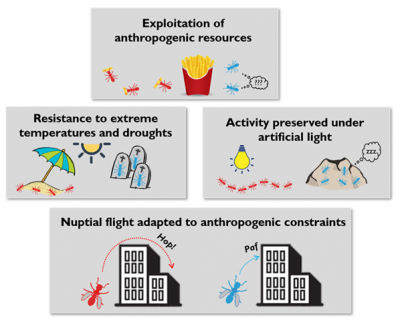
Thus, while many species are rarely found in urban areas, several species of ants are on the contrary common in the most anthropized habitats (e.g. Lasius niger in France, Figure 5). Ant communities are therefore frequently studied in urban ecology, because of the important differences between communities in urbanized habitats and those found in adjacent rural habitats [17].
4. Invasive ants
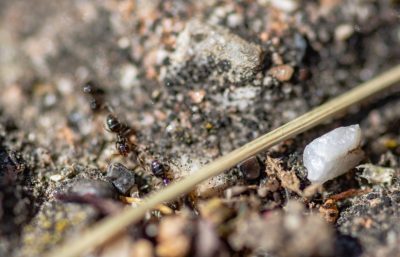
Among social insects, some species are much talked about, such as the infamous Asian Hornet Vespa velutina, whose impact on honey bees has been widely studied in recent years [18]. However, ants are certainly the most destructive and widespread. The Invasive Species Research Group [19] has shown that among the 100 most damaging invasive species in the world, five are ants: the Argentine ant (Linepithema humile), the fire ant (Solenopsis invicta), the big-headed ant (Pheidole megacephala), the small fire ant (Wasmannia auropunctata), and the yellow mad ant (Anoplolepis gracilipes).
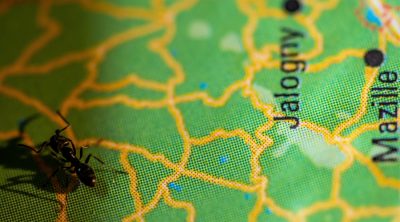
Ant invasions have very high economic costs, strongly alter the environment and have a strong impact on native biodiversity. Local ant species in particular can be very negatively impacted by invasive species due to their competitive dominance, predation and nest raiding. Invasive ants also have an impact on many components of ecosystem functioning, ecosystem services [21] and human societies, such as changes in food web dynamics, alterations in nutrient cycling or reduced pollination [12].
5. When global changes interact
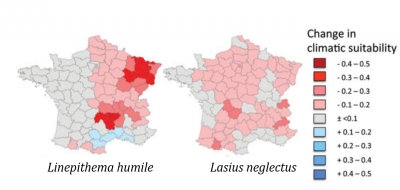
- An increase in the rate of import of non-indigenous individuals due to increased accidental or intentional transport into cities as a result of constant human flows, for example through food chains (e.g. the import of fruit for the Japanese fruit fly Drosophila suzukii), or as a result of the import of exotic pets (the Florida turtle or the collared parakeet are good examples);
- The presence of habitats favourable to the establishment of non-native species, with a favourable combination of resources and environmental conditions, and few natural enemies (predators or competitors), thus greatly improving the invader’s habitability;
- The fact that imported non-native species include among them species that can tolerate the unique conditions of anthropized habitats (e.g. tropical species resistant to higher temperatures), or even species that can take advantage of the opportunities offered by urban environments, as is the case for the tiger mosquito (see also Why is the tiger mosquito so invasive?).
Climate change may also exacerbate biological invasions, as the distribution of many invasive species is currently limited by thermal barriers. Climate change could thus allow them to invade higher latitudes. Extreme weather events, such as intense heat waves, hurricanes, floods and droughts, can facilitate biological invasions by increasing the movement of non-native species and decreasing the resistance of native communities to the establishment of invaders (see Climate change and globalization, drivers of insect invasions). For example, in France, most invasive ant species are likely to increase their range in response to climate change (Figure 7) [23].
6. The Case of the Pavement Ant
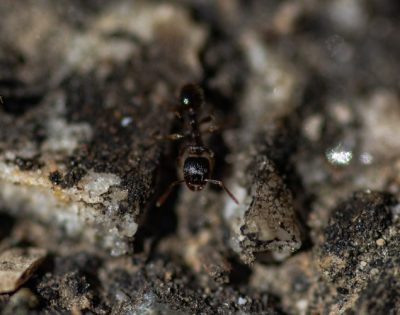
In France, the spatial distribution of T. immigrans depends both on climatic and urbanization conditions at different spatial scales [24]. This species, which prefers warm and relatively humid environments, is strongly represented in anthropized micro-habitats, e.g. characterized by the presence of concrete. In the northern part of its distribution, this species is often restricted to the most urbanized habitats. Even further north, in regions that are not climatically favourable to it beyond its referenced distribution area, it is even found exclusively in large cities such as Paris or Prague. Figure 9 illustrates the capacity of this species to exploit human resources in urbanized habitats [25]. Thus, in many large cities in northern France, the effects of urban heat islands allow it to survive despite the inhospitable climatic conditions in these regions.
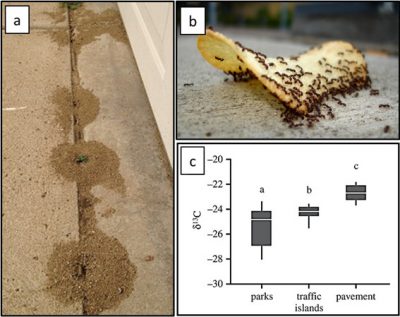
7. Species distribution and multi-scale interactions
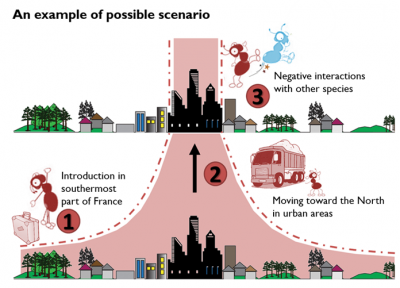
However, climate change, changes in land use or the introduction of invasive alien species are likely to occur simultaneously, and thus synergistic effects on biodiversity can be expected. For example, cities are often warmer than neighbouring rural habitats, and the impact of urbanization on climate is locally comparable to ongoing global warming, suggesting that urbanization could strongly reinforce the consequences of climate change at the local level. This complexity, involving scale effects and interaction effects, emerges even when considering only two global changes (here, climate change and urbanization). But these effects are probably catalysed by other major anthropogenic changes, such as pollution, agriculture, or deforestation.
Clearly, a simple causality study involving a partially described global change in the distribution of a species cannot therefore lead to a convincing understanding of the processes underlying the distribution of species. It is therefore fundamental to conduct in-depth studies on the impacts of global changes with more inclusive approaches combining several changes at several scales. To this end, ants will certainly be a model of choice, as they have already proved their ability to unravel such issues. While in the past they have made it possible to study most of these global changes individually, no doubt in the future they will make it possible to understand how they interact and to quantify their simultaneous impacts on biodiversity in greater detail…
8. Messages to remember
- Climate change and urbanization are interacting and changing the distribution of species.
- Ants are abundant and diverse, have colonized most terrestrial habitats and influence many ecosystem functions.
- Small and nesting in soil or plants, they are easily transported by humans. As a result, they now include many invasive species.
- Ants are ectothermic insects and are therefore sensitive to temperature variations. Their distribution is therefore highly dependent on climatic conditions.
- Ants are frequently studied in urban ecology because they are good indicators of the environmental impact of urbanization.
- Consequently, ants are very suitable models for studying the complex interactions between global changes – the study of the pavement ant (Tetramorium immigrans) is a good illustration of this.
Notes and References
Cover image. Pavement ant Tetramorium immigrans in an urbanized environment. [Source: © Benjamin Gerfand]
[1] https://www.un.org/en/events/citiesday/assets/pdf/the_worlds_cities_in_2018_data_booklet.pdf
[2] Antrop, M. (2004). Landscape change and the urbanization process in Europe. Landscape and urban planning, 67(1-4), 9-26.
[3] Seress, G., et al. 2014. Quantifying the urban gradient: a practical method for broad measurements. Landscape and Urban Planning, 131, 42-50.
[4] https://www.notre-planete.info/terre/climatologie_meteo/ilot-chaleur-urbain.php
[5] McKinney, M. L. (2006). Urbanization as a major cause of biotic homogenization. Biological conservation, 127(3), 247-260.
[6] In ecology, edge effects reflect changes in the structure of species populations and communities that occur when two very different habitats exist side by side in an ecosystem. This terminology is often used to refer to the boundaries between natural and artificial habitats.
[7] Invasions of non-native species introduced voluntarily or involuntarily outside their original range and capable of persisting and proliferating in newly colonized ecosystems
[8] Ricciardi, A. (2007). Are modern biological invasions an unprecedented form of global change? Conservation Biology, 21(2), 329-336.
[9] Pyšek, P., et al (2017). Displacement and local extinction of native and endemic species. In Impact of biological invasions on ecosystem services (pp. 157-175). Springer, Cham.
[10] Gurnell, J., et al. 2004. Alien species and interspecific competition: effects of introduced eastern grey squirrels on red squirrel population dynamics. Journal of Animal Ecology, 73(1), 26-35.
[11] https://www.nature.com/scitable/knowledge/library/an-introduction-to-eusociality-15788128/
[12] Hölldobler, B., & Wilson, E. O. (1990). The ants. Harvard University Press.
[13] Lach, L., Parr, C., & Abbott, K. (Eds.). (2010). Ant ecology. Oxford University Press.
[14] Miravete, V., et al (2014). How many and which ant species are being accidentally moved around the world? Biology letters, 10(8), 20140518.
[15] Sung, S., et al (2018). Predicting the potential distribution of an invasive species, Solenopsis invicta Buren (Hymenoptera: Formicidae), under climate change using species distribution models. Entomological Research, 48(6), 505-513.
[16] Heterick, B. E., et al. (2013). Urbanisation factors impacting on ant (Hymenoptera: Formicidae) biodiversity in the Perth metropolitan area, Western Australia: Two case studies. Urban Ecosystems, 16(2), 145-173.
[17] Philpott, S. M., et al. 2010. Ant diversity and function in disturbed and changing habitats. Ant Ecology. Oxford University Press, New York, 137-157.
[18] http://frelonasiatique.mnhn.fr/la-museliere/
[19] http://www.issg.org/
[20] Ascunce, M. S., et al. 2011. Global invasion history of the fire ant Solenopsis invicta. Science, 331(6020), 1066-1068.
[21] Goods and services that humans can derive from ecosystems, directly or indirectly, to ensure their well-being (Millennium Ecosystem Assessment, 2005).
[22] Cadotte, M. W., et al (2017). Are urban systems beneficial, detrimental, or indifferent for biological invasion? Biological invasions, 19(12), 3489-3503.
[23] Bertelsmeier, C., & Courchamp, F. (2014). Future ant invasions in France. Environmental conservation, 41(2), 217-228.
[24] Cordonnier, M., et al (2019). Multi-scale impacts of urbanization on species distribution within the genus Tetramorium. Landscape Ecology, 34(8): 1937-1948.
[25] Penick, C. A., et al. 2015. Stable isotopes reveal links between human food inputs and urban ant diets. Proc. R. Soc. B, 282(1806), 20142608.
[26] Cordonnier, M., et al (2020). Effect of the urbanization-climate interaction on the expansion of the pavement ant in South-eastern France. Basic and Applied Ecology, 44, 46-54.
[27] Cordonnier, M., et al (2019). From hybridization to introgression between two closely related sympatric ant species. J Zool Syst Evol Res, 57(4): 778-788.
The Encyclopedia of the Environment by the Association des Encyclopédies de l'Environnement et de l'Énergie (www.a3e.fr), contractually linked to the University of Grenoble Alpes and Grenoble INP, and sponsored by the French Academy of Sciences.
To cite this article: CORDONNIER Marion (January 5, 2025), Ants as sentinels of the impact of global change, Encyclopedia of the Environment, Accessed March 30, 2025 [online ISSN 2555-0950] url : https://www.encyclopedie-environnement.org/en/life/ants-sentinels-impact-global-change-2/.
The articles in the Encyclopedia of the Environment are made available under the terms of the Creative Commons BY-NC-SA license, which authorizes reproduction subject to: citing the source, not making commercial use of them, sharing identical initial conditions, reproducing at each reuse or distribution the mention of this Creative Commons BY-NC-SA license.




